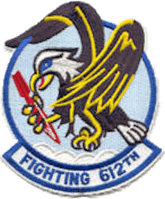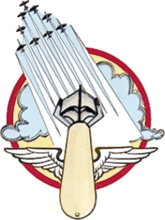612th Tactical Fighter Squadron
612th Tactical Fighter Squadron
 | |
|---|---|
|
| |
| Active | 1943-1945, 1949-1951, 1954-1991 |
| Country |
|
| Branch |
|
| Role | Fighter |
| Nickname(s) | Fighting 612th |
| Insignia | |
| 612th Tactical Fighter Squadron patch showing squadron emblem (approved 15 September 1955)[1] |
 |
| 612th Bombardment Squadron Emblem[2] |
 |
| ETO Fuselage Code[3] | FN |
The 612th Tactical Fighter Squadron is an inactive United States Air Force unit. Its last was assigned to the 401st Tactical Fighter Wing, stationed at Torrejon Air Base, Spain. It was inactivated on 1 October 1991.
History
World War II
Organization and training for combat
The 612th Bombardment Squadron was activated March 1943 at Ephrata Army Air Base Washington as one of the original squadrons of the 401st Bombardment Group.[1][4] The initial cadre for the squadron was drawn from the 395th Bombardment Group at Ephrata and the 383d Bombardment Group at Rapid City Army Air Field, South Dakota. The cadre soon departed for Orlando Army Air Base, Florida, where they conducted simulated combat missions with the Army Air Forces School of Applied Tactics out of Brooksville Army Air Field.[5]
The ground echelon moved to Geiger Field, Washington in May 1943 and to Great Falls AAB, Mount in July. At Great Falls the first combat crews were assigned to the squadron.[6] In the final stage of training the squadrons dispersed with the 612th remaining at Great Falls, while the other squadrons trained at bases in Montana and Wyoming.[7]
After completing training the ground echelon left for overseas on 19 October 1943. After staging at Camp Shanks, New York they embarked on the RMS Queen Mary and sailed on 27 October disembarking at Greenock on the Firth of Clyde on 3 November 1943. The air echelon staged for deployment at Scott Field, Illinois then flew to England under the control of Air Transport Command via Newfoundland, Iceland and Scotland.[7]
Combat in the European Theater of Operations
On arrival in England, half of the 401st group's aircrews were immediately reassigned to the 351st Bombardment Group.[7] The rest of the squadron became part of Eighth Air Force at RAF Deenethorpe. The 612th became part of the 92d Combat Bombardment Wing of the 1st Bombardment Division. Its tail code was Triangle-S.
On 26 November the 612th flew its first combat mission against Bremen, Germany.[8] The 401st group did not suffer the combat loss of an airplane until its ninth mission on 30 December.[9] The squadron operated chiefly against strategic targets, bombing industries, submarine facilities, shipyards, missile sites, marshalling yards, and airfields.[4] On 11 January 1944 the squadron was in the lead group of the 1st Bombardment Division in an attack against aircraft manufacturing facilities at Ochsersleben, Germany. Although the bombers were able to attack, poor weather conditions prevented the division from receiving effective fighter cover. For over three hours the bomber formation suffered more than 400 attacks by Luftwaffe fighters, including air-to-air rocket attacks. Despite these attacks the unit continued its attack and struck a telling blow against German aircraft production for which the squadron was awarded the Distinguished Unit Citation (DUC).[4][10]
A little over a month later, on 20 February, the squadron earned its second DUC for an attack on the Erla Maschinenwerke aircraft manufacturing facilities in Leipzig, Germany. Despite fighter attacks and battle damage to the 612th's planes, 100% of the unit’s bombs fell within 1000 feet of the aiming point.[4][11] Beginning in October 1944, the unit concentrated its attacks on Axis oil reserves.[4]
In addition to strategic missions, squadron operations included attacks on transportation, airfields, and fortifications prior to the Normandy invasion. On D-Day the 612th attacked Normandy beachhead areas dropping bombs five minutes before troops landed.[12] The following month it provided close air support for the breakthrough at Saint-Lô, it also supported the siege of Brest in August and Operation Market Garden in September. During the Battle of the Bulge in December 1944 and January 1945, the unit attacked transportation and communications in the battle area. It supported airborne forces involved in Operation Varsity in March 1945.[4]
The squadron flew its last combat mission on 20 April 1945 against Brandenberg.[13] It had flown 254 combat missions from Deenethorpe airfield.[14] After V-E Day, the squadron flew missions to Linz, Austria to evacuate British and French prisoners of war. It also flew Trolley sightseeing missions at low level, flying ground support personnel over the Ruhr and Frankfurt am Main to see the damage that had been done as a result of their efforts.[15]
The unit was alerted for redeployment to the Pacific Theater and the last plane departed Deenethorpe in early June. The ground echelon sailed on the RMS Queen Elizabeth on the fifth.[16] Upon arrival in the US, personnel were granted thirty days leave, reassembling at Sioux Falls Army Air Field, South Dakota, but plans had changed and personnel were either transferred to Boeing B-29 Superfortress units or processed for discharge and the squadron was inactivated.[17]
Reserve Operations
Assigned to Air Force Reserve January 1947. Never equipped or manned, inactivated 1949.
Cold War
Allocated to Tactical Air command, 1953 and reactivated as a Fighter-Bomber, later Tactical Fighter squadron. Performed routine deployments and exercises 1954-1965. Reassigned to Japan in 1965 as part of air defense mission over Japan and South Korea, performed rotational deployments to South Korean air bases. Deployed to South Vietnam in 1971 for close air support and interdiction combat missions in support of South Vietnamese operations in Laos and Cambodia AORs, March–July 1971.
Redeployed to NATO in mid-1971 as part of USAF drawdown of forces in Indochina. Assigned to USAFE in Spain, performed routine deployments and exercises. Inactivated in 1991 as part of USAF drawdown of forces in Europe after the end of the Cold War.
Lineage
- Constituted as the 612th Bombardment Squadron (Heavy) on 20 March 1943
- Activated on 1 April 1943
- Redesignated 612th Bombardment Squadron, Heavy ca. 1 November 1943
- Inactivated on 28 August 1945
- Redesignated 612th Bombardment Squadron, Very Heavy on 27 May 1947
- Activated in the reserve on 26 June 1947
- Redesignated 612th Bombardment Squadron, Medium on 27 June 1949
- Ordered to active service on 1 May 1951
- Inactivated on 25 June 1951
- Redesignated 612th Fighter-Bomber Squadron on 24 November 1953
- Activated on 8 February 1954
- Redesignated 612th Tactical Fighter Squadron on 1 July 1958
- Inactivated on 1 October 1991.
Assignments
- 401st Bombardment Group, 1 April 1943 – 28 August 1945
- 401st Bombardment Group, 26 June 1947 – 25 June 1951
- 401st Fighter-Bomber Group, 8 February 1954
- 401st Fighter-Bomber Wing (later Tactical Fighter Wing), 25 September 1957
- 475th Tactical Fighter Wing, 3 November 1965
- 35th Fighter Wing, 15 March 1971
- 401st Tactical Fighter Wing, 15 July 1971 – 1 October 1991
Stations
|
|
Aircraft
- Boeing B-17 Flying Fortress, 1943–1945
- North American F-86 Sabre, 1954–1955
- Republic F-84 Thunderjet, 1954–1957
- North American F-100 Super Sabre, 1957–1971
- McDonnell Douglas F-4 Phantom II, 1971–1983
- General Dynamics F-16 Fighting Falcon, 1983–1991
Awards and Campaigns
| Award streamer | Award | Dates | Notes |
|---|---|---|---|
| Distinguished Unit Citation | 11 January 1944 | Germany 612th Bombardment Squadron[1] | |
| Distinguished Unit Citation | 20 February 1944 | Germany 612th Bombardment Squadron[1] | |
| Air Force Outstanding Unit Award | 1 January 1963 - 31 December 1963 | 612th Tactical Fighter Squadron[1] |
| Campaign Streamer | Campaign | Dates | Notes |
|---|---|---|---|
| Air Offensive, Europe | 612th Bombardment Squadron[1] | ||
| Normandy | 612th Bombardment Squadron[1] | ||
| Ardennes-Alsace | 612th Bombardment Squadron[1] | ||
| Northern France | 612th Bombardment Squadron[1] | ||
| Rhineland | 612th Bombardment Squadron[1] | ||
| Central Europe | 612th Bombardment Squadron[1] |
References
Notes
- 1 2 3 4 5 6 7 8 9 10 11 Maurer, Combat Squadrons, p. 684
- ↑ The squadron had an earlier emblem portraying the squadron mascot, "Mangler." Closway, p. 36
- ↑ Watkins, pp. 86–87
- 1 2 3 4 5 6 Maurer, Combat Units, pp. 285–286
- ↑ Closway, p. 44
- ↑ Closway, pp. 44-45
- 1 2 3 Closway, p. 45
- ↑ Closway, p. 46
- ↑ Closway, p. 47
- ↑ Closway, pp. 40, 47, 62 (reproducing War Department General Order 50, 17 June 1944)
- ↑ Closway, pp. 40, 63 (reproducing War Department General Order 83, 2 October 1945)
- ↑ Closway. p. 43
- ↑ Closway, p. 55
- ↑ Closway, p. 62
- ↑ Closway, pp. 56-57
- ↑ Closway, p. 58
- ↑ Closway, p. 59
- ↑ Station number in Anderson
Bibliography
![]() This article incorporates public domain material from the Air Force Historical Research Agency website http://www.afhra.af.mil/.
This article incorporates public domain material from the Air Force Historical Research Agency website http://www.afhra.af.mil/.
- Anderson, Capt. Barry (1985). Army Air Forces Stations: A Guide to the Stations Where U.S. Army Air Forces Personnel Served in the United Kingdom During World War II (PDF). Maxwell AFB, AL: Research Division, USAF Historical Research Center. Retrieved July 7, 2012.
- Maurer, Maurer, ed. (1983) [1961]. Air Force Combat Units of World War II (PDF) (reprint ed.). Washington, DC: Office of Air Force History. ISBN 0-912799-02-1. LCCN 61060979.
- Closway, Gordon R., ed. (1946). Pictorial Record of the 401st Bomb Group. San Angelo, TX: Newsfoto Publishing Co. Retrieved September 10, 2013.
- Maurer, Maurer, ed. (1982) [1969]. Combat Squadrons of the Air Force, World War II (PDF) (reprint ed.). Washington, DC: Office of Air Force History. ISBN 0-405-12194-6. LCCN 70605402. OCLC 72556.
- Watkins, Robert (2008). Battle Colors: Insignia and Markings of the Eighth Air Force In World War II. Vol I (VIII) Bomber Command. Atglen, PA: Shiffer Publishing Ltd. ISBN 0-7643-1987-6.
